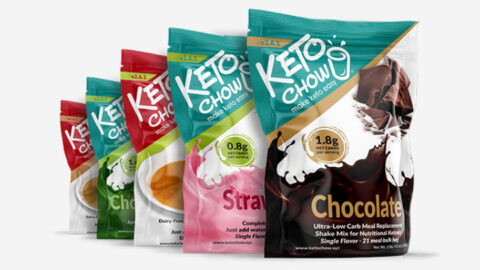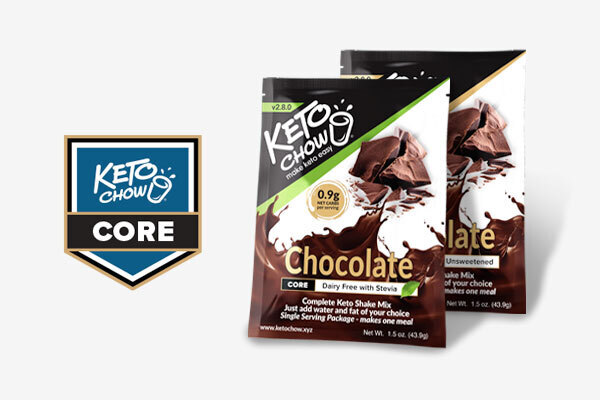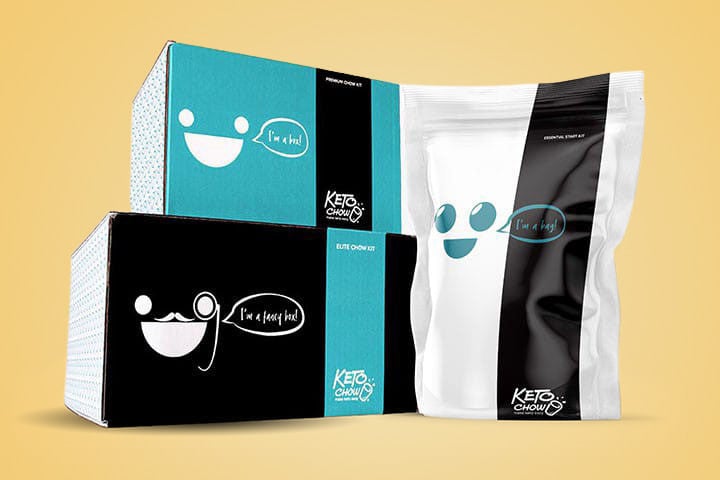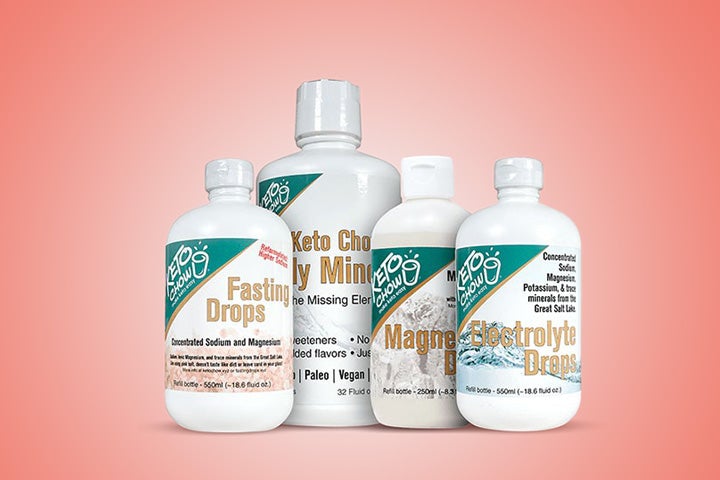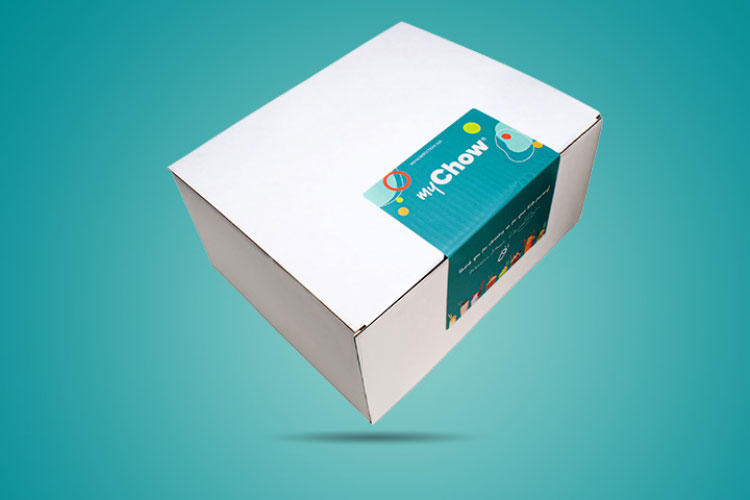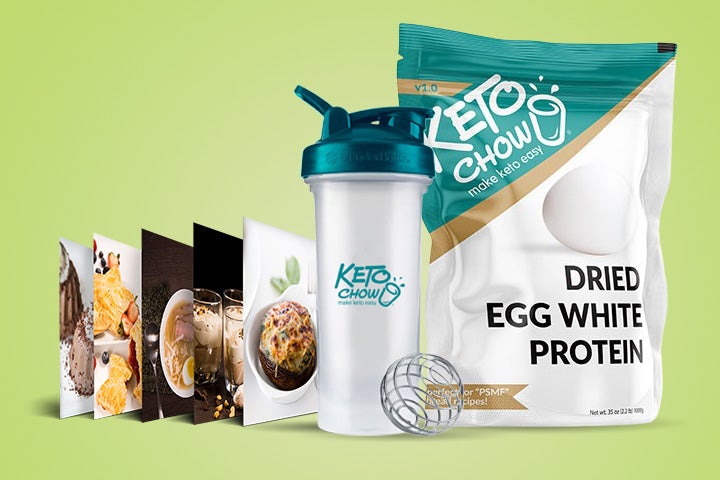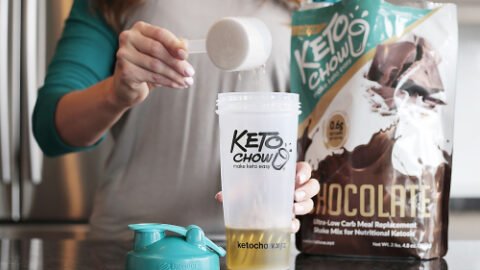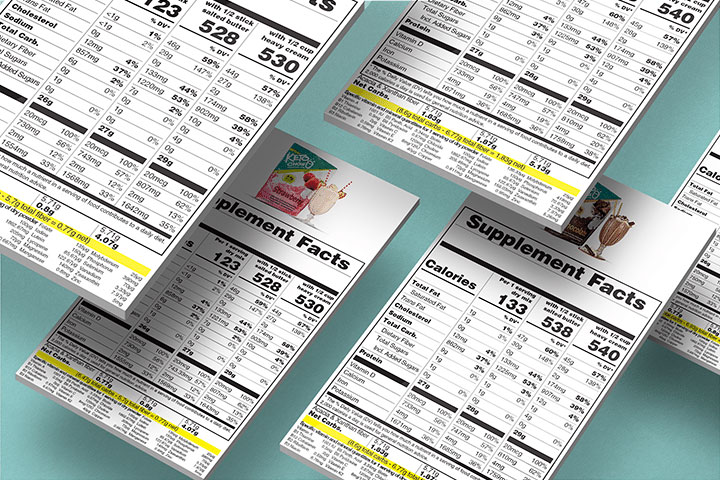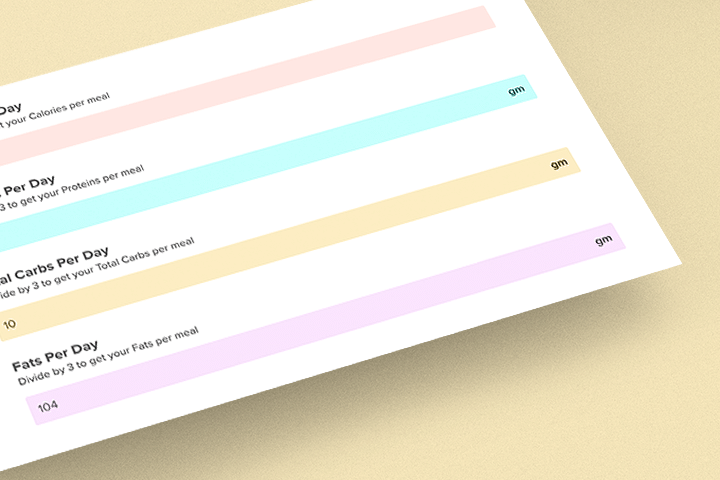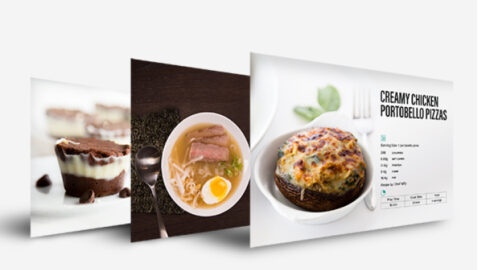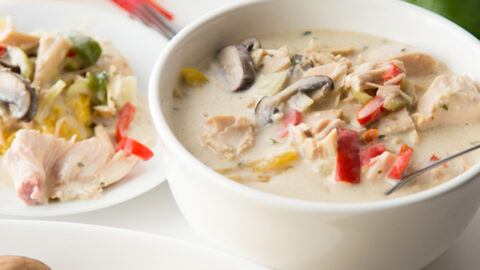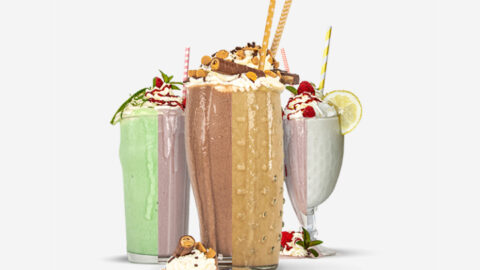Nutrition.
our goal
One of the main goals of Keto Chow is to be convenient, the second is for it to give you everything you need to thrive: complete nutrition. This page has details about what nutrition is in Keto Chow, a bit about why it’s in there, some information about what’s NOT in Keto Chow.
Quick Facts:
NET CARBS
0.8g
Sodium - 0.9g
48% DV
Protein - 26g
52% DV
Magnesium - 0.22g
54% DV
Potassium - 1.5g
38% DV
Contains:
- Milk or Beef Protein from the USA (depends on flavor)
- Acacia Gum
- Vitamin K2
- Vitamin D3 at current optimum levels
- Sodium, Potassium, Magnesium, and other electrolytes to prevent “keto flu”
- Optimum Vitamin and Mineral amounts based on current science
- Choline L-Bitartrate (as opposed to DL)
- Folate as (6S)-5-METHYL TETRAHYDROFOLIC ACID (handy if you have MTHFR problems)
Doesn't Contain:
- Maltitol
- Trans Fat
- Gluten
- Aspartame
- Soy Protein
- Added sugar
- Excessive Fiber
- Acesulfame Potassium (AceK)
- Peanuts (Except the Peanut Butter Flavor)
- Heavy Metals
Why we use certain ingredients and not others:
This is here for design/coding purposes. Please do not delete.
In a previous version, Keto Chow utilized Psyllium Husk powder for fiber. I’m very happy that we switched over to Acacia Gum. It’s water soluble so it has no texture and has some great benefits for ketosis and general gut health. Notably, it’s fermented by gut bacteria into short chain fatty acids that make keto happy.
What you won’t find in Keto Chow is the FDA recommended 28g of dietary fiber per day. I had considered adding additional acacia gum but was reminded about some fun fiber facts on the HighSteaks site:
The simple idea that we should be filling our digestive systems with something indigestible is utter madness.
Seek out the evidence for yourself – here’s a hint, there’s none whatsoever that fiber is something you should be consuming much of (if any), and almost certainly should NOT be supplementing.
Sure, eat some foods which happen to be rich in fiber if you like them and can tolerate them well, but it’s not the fiber that makes them worth eating.
The go-to line about it all: “Fiber is great – if you live on junk food.”
Keto Chow uses 0.08g (80mg) of sucralose. Many confuse sucralose with the brand name, Splenda, which contains maltodextrin as a bulking agent. You won’t find any of that in Keto Chow. If you’re concerned, you can read the Wikipedia page regarding sucralose and draw your own conclusions. We don’t use any other artificial sweeteners (Acesulfame Potassium, Aspartame, Saccharin). We also do not use Maltitol or any other sugar alcohol.
We don’t use anything but sucralose because there really isn’t a need to do so. By limiting the number used, it simplifies things greatly – fewer questions to answer. It should be noted that if you do not like sucralose or want to use your own flavoring, we have the “Natural Strawberry” which uses monk fruit as a sweetener, and we have the Keto Chow Base Powder available as an option. It contains all of the vitamins, minerals and other ingredients EXCEPT for the protein, the sweetener, and the flavoring. You mix it with a protein of your choosing.
Our primary manufacturing facility has an employee that’s allergic to peanuts – producing the Chocolate Peanut Butter flavor (which contains actual peanut flour, not just peanut flavor) at that facility was not an option. Instead, the Chocolate Peanut Butter flavor is mixed and packaged at a different location. The result is that all of our flavors, except chocolate peanut butter, are completely peanut free.
Depending on your taste and how long you let Keto Chow “rest” in the fridge after mixing (30 minutes minimum, overnight preferred), you may find Keto Chow rather salty at first. This isn’t by accident, it’s an essential feature.
When you do keto, your body will burn through electrolytes rather quickly. There are several mechanisms at work that cause this but the end result is that you need higher than normal electrolyte amounts. If you don’t get enough you may experience nausea, cramping, fatigue and other flu-like symptoms. This is why the condition is commonly referred to as “Keto Flu”. The fix is easy: get some sodium, potassium, and/or magnesium. Keto Chow, by design, should allow you to completely avoid the Keto Flu, so long as your other meals (if you’re eating other keto food) contain sufficient electrolytes.
Most people find that the saltiness goes away after letting it refrigerate overnight (or longer). You may also actually start to crave the saltiness as your body adjusts to ketosis and the higher electrolyte requirements.
Soy is a funny thing. There’s a lot of “well I heard it from a dude at the gym that soy gives you cancer” information running around. There is very, very little scientific information based on studies to back up the concerns about phytoestrogens in soy protein causing problems in vivo with humans. Regardless: Keto Chow does not use any soy protein (which is the problem-child and what people can be allergic to) or soy ANYTHING.
Governmental Information:
This is here for design/coding purposes. Please do not delete.
| Nutrient | Unit of measure | Adults and Children ≥ 4 years | Infants – 12 months | Children 1 – 3 years | Pregnant women and lactating women |
| Fat | Grams (g) | 78 | 30 | 39 | 78 |
| Saturated fat | Grams (g) | 20 | N/A | 10 | 20 |
| Cholesterol | Milligrams (mg) | 300 | N/A | 300 | 300 |
| Total Carbohydrates | Grams (g) | 275 | 95 | 150 | 275 |
| Sodium | Milligrams (mg) | 2,300 | N/A | 1,500 | 2,300 |
| Dietary Fiber | Grams (g) | 28 | N/A | 14 | 28 |
| Protein | Grams (g) | 50 | N/A | 13 | 71 |
| Added Sugars | Grams (g) | 50 | N/A | 25 | 50 |
| Vitamin A | Micrograms RAE (mcg) | 900 | 500 | 300 | 1,300 |
| Vitamin C | Milligrams (mg) | 90 | 50 | 15 | 120 |
| Calcium | Milligrams (mg) | 1,300 | 260 | 700 | 1,300 |
| Iron | Milligrams (mg) | 18 | 11 | 7 | 27 |
| Vitamin D | Micrograms (mcg) | 20 | 10 | 15 | 15 |
| Vitamin E | Milligrams (mg) | 15 | 5 | 6 | 19 |
| Vitamin K | Micrograms (mcg) | 120 | 2.5 | 30 | 90 |
| Thiamin | Milligrams (mg) | 1.2 | 0.3 | 0.5 | 1.4 |
| Riboflavin | Milligrams (mg) | 1.3 | 0.4 | 0.5 | 1.6 |
| Niacin | Milligrams NE (mg) | 16 | 4 | 6 | 18 |
| Vitamin B6 | Milligrams (mg) | 1.7 | 0.3 | 0.5 | 2 |
| Folate | Micrograms DFE (mcg) | 400 | 80 | 150 | 600 |
| Vitamin B12 | Micrograms (mcg) | 2.4 | 0.5 | 0.9 | 2.8 |
| Biotin | Micrograms (mcg) | 30 | 6 | 8 | 35 |
| Pantothenic acid | Milligrams (mg) | 5 | 1.8 | 2 | 7 |
| Phosphorus | Milligrams (mg) | 1,250 | 275 | 460 | 1,250 |
| Iodine | Micrograms (mcg) | 150 | 130 | 90 | 290 |
| Magnesium | Milligrams (mg) | 420 | 75 | 80 | 400 |
| Zinc | Milligrams (mg) | 11 | 3 | 3 | 13 |
| Selenium | Micrograms (mcg) | 55 | 20 | 20 | 70 |
| Copper | Milligrams (mg) | 0.9 | 0.2 | 0.3 | 1.3 |
| Manganese | Milligrams (mg) | 2.3 | 0.6 | 1.2 | 2.6 |
| Chromium | Micrograms (mcg) | 35 | 5.5 | 11 | 45 |
| Molybdenum | Micrograms (mcg) | 45 | 3 | 17 | 50 |
| Chloride | Milligrams (mg) | 2,300 | 570 | 1,500 | 2,300 |
| Potassium | Milligrams (mg) | 4,700 | 700 | 3,000 | 5,100 |
| Choline | Milligrams (mg) | 550 | 150 | 200 | 550 |
Strangely enough, Norway seems to have better-documented science behind their dietary recommendations. You can peruse the full PDF for detailed information about each nutrient. Want to know the upper tolerable limit for Iron and why that’s the limit? It’s all in the PDF. They do still have some rather silly stuff about saturated fats and carbohydrates but they’re moving in a good direction. We’ll see what the 2020 report says =)
Info about the 2012 recommendations in this PDF.
Nutritional Information
 Nutrition for Salted Caramel shown above. See the Change Log for a complete list of changes to the recipe.
Nutrition for Salted Caramel shown above. See the Change Log for a complete list of changes to the recipe.| Alanine | 0.81g | Glutamic Acid | 5.19g | Leucine | 2.31g | Proline | 2.43g | Tyrosine | 1.32g |
| Arginine | 0.93g | Glycine | 0.45g | Lysine | 2.04g | Serine | 1.35g | Valine | 1.56g |
| Aspartic Acid | 1.83g | Histidine | 0.66g | Methionine | 0.72g | Threonine | 1.05g | ||
| Cystine | 0.27g | Isoleucine | 1.29g | Phenylalanine | 1.20g | Tryptophan | 0.36g |
 Nutrition for v2.5 Beef Soup Base shown above . See the Change Log for a complete list of changes to the recipe.
Nutrition for v2.5 Beef Soup Base shown above . See the Change Log for a complete list of changes to the recipe.| Alanine | 2.14 g | Glycine | 4.93 g | Lysine | 0.93 g | Threonine | 0.53 g |
| Arginine | 1.82 g | Histadine | 0.27 g | Methionine | 0.23 g | Tryptophan | 0.08 g |
| Aspartic | 1.48 g | Hydroxyproline | 2.38 g | Phenylalanine | 0.58 g | Tyrosine | 0.31 g |
| Cysteine | 0.03 g | Isoleucine | 0.42 g | Proline | 2.95 g | Valine | 0.72 g |
| Glutamic | 2.71 g | Leucine | 0.92 g | Serine | 0.83 g |
Sweet flavors
Savory flavors
 Nutrition for Salted Caramel shown above. See the Change Log for a complete list of changes to the recipe.
Nutrition for Salted Caramel shown above. See the Change Log for a complete list of changes to the recipe.| Alanine | 0.81g | Glutamic Acid | 5.19g | Leucine | 2.31g | Proline | 2.43g | Tyrosine | 1.32g |
| Arginine | 0.93g | Glycine | 0.45g | Lysine | 2.04g | Serine | 1.35g | Valine | 1.56g |
| Aspartic Acid | 1.83g | Histidine | 0.66g | Methionine | 0.72g | Threonine | 1.05g | ||
| Cystine | 0.27g | Isoleucine | 1.29g | Phenylalanine | 1.20g | Tryptophan | 0.36g |
 Nutrition for v2.5 Beef Soup Base shown above . See the Change Log for a complete list of changes to the recipe.
Nutrition for v2.5 Beef Soup Base shown above . See the Change Log for a complete list of changes to the recipe.| Alanine | 2.14 g | Glycine | 4.93 g | Lysine | 0.93 g | Threonine | 0.53 g |
| Arginine | 1.82 g | Histadine | 0.27 g | Methionine | 0.23 g | Tryptophan | 0.08 g |
| Aspartic | 1.48 g | Hydroxyproline | 2.38 g | Phenylalanine | 0.58 g | Tyrosine | 0.31 g |
| Cysteine | 0.03 g | Isoleucine | 0.42 g | Proline | 2.95 g | Valine | 0.72 g |
| Glutamic | 2.71 g | Leucine | 0.92 g | Serine | 0.83 g |
FAQ:
This item is here for design reasons, please do not delete.
The different flavors of Keto Chow have various ingredients for flavoring, here are some of the major allergens and which (if any) flavors have them.
Gluten and wheat: All flavors of Keto Chow are gluten-free and wheat-free.
Soy: All flavors of Keto Chow are soy-free.
Peanuts: Chocolate Peanut Butter, Nutmeg, Eggnog, Pumpkin Spice Caramel
Tree Nuts (almonds, hazelnuts, walnuts, brazil nuts, cashews, pecans, pistachios and macadamia nuts, etc…): Aside from nutmeg, all flavors of Keto Chow are tree nut-free.
Dairy: All but 4 flavors HAVE dairy proteins, the dairy-free flavors are: Base Powder, Creamy Tomato Basil, Spicy Taco Soup Base, Beef Soup Base.
Eggs: Eggnog
Fish: All flavors of Keto Chow are fish-free.
Lupin: All flavors of Keto Chow are lupin-free.
Shellfish and Mollusks: All flavors of Keto Chow are shellfish-free.
Sesame: All flavors of Keto Chow are sesame-free.
The only official statement we can legally give is the disclaimer at the bottom of the Keto Chow site:
The content of this website is not intended for the treatment or prevention of disease, nor as a substitute for medical treatment, nor as an alternative to medical advice. Use of recommendations is at the choice and risk of the reader. If you are on any medication, please consult with your family doctor before starting any new eating plan. Keto Chow is not intended to treat, cure or prevent any disease. Pregnant or breast feeding women should consult their health care professional before consuming.
Take a printout of the nutrition and ingredients to your doctor and have a discussion with them. Not a “sit there and listen to them” but working together to determine what will work for you. To my knowledge, there’s nothing specific to Keto Chow that would be any more detrimental to mother or child than a typical keto diet. The real question to ask is the safety of a keto diet during your pregnancy/nursing. The internet is not the place to make that determination. The only issue we have heard reported is: don’t use MCT oil while nursing. Not that it is bad – it just tends to make babies mad. There are some amazing resources over on the Keto Babies Reddit.
There are several key differences between 1.5 (the version you can make yourself) and 2.0+. Some are also differences from 1.5 to 1.9.
- A custom-made vitamin and mineral pre-mix. This replaces several ingredients (the vitamin pill, Calcium Phosphate, Vitamin K, Choline L-Bitartrate, Calcium/Magnesium Citrate, Vitamin D3). There’s also more Magnesium. Other vitamins and minerals have also been adjusted above minimum levels to optimal levels, and optimal forms for bioavailability.
- Additional Potassium to comply with the new US dietary requirements.
- Better Magnesium source that makes is a lot easier on digestion.
- Protein Isolate which has significantly lower carbohydrates compared to the concentrate/isolate/hydrolyzed protein blend used in 0.7-1.9. Most flavors are only 0.56g net carbs before adding any heavy cream.
- Custom made flavors. Earlier versions used off-the-shelf protein powder with flavoring. Using our own makes the flavors more stable and lowers the cost.
- Eliminated 2 sweeteners: AceK and Stevia
- Mixed and packaged in a different facility. All of the flavors (except Chocolate Peanut Butter) are now completely peanut-free and safe for people with peanut allergies.
The Natural Strawberry uses monk fruit as a sweetener
The Savory Chicken Soup, Creamy Tomato Basil, Spicy Taco Base, Beef Soup Base, and Base Powder contain no sweetener.
The other flavors of Keto Chow use 0.08g (80mg) of pure sucralose. Many confuse sucralose with its brand name, Splenda, which contains maltodextrin as a bulking agent. You won’t find any of that in Keto Chow.
You can read more about Sucralose and its benefits and issues here. We don’t use any other artificial sweeteners (acesulfame potassium, aspartame, saccharin). We also do not use maltitol or any other sugar alcohol.
This item is here for design reasons, please do not delete.
Depending on the flavor, Keto Chow uses either milk protein isolate or beef protein and beef bone broth. You can find the amino acid profiles for those on the nutrition labels above.
There are nine “essential” amino acids. Meaning, your body can’t synthesize them: phenylalanine, valine, threonine, tryptophan, methionine, leucine, isoleucine, lysine, and histidine. You can find all nine in both protein-types of Keto Chow.
More info here on Wikipedia
Summary: The glycemic index/load is very small. Too small to be accurately tested.
First things first, you need to understand how the Glycemic Index is measured in foods:
GI values of foods must be measured using valid scientific methods. It cannot be guessed by looking at the composition of the food or the nutrition information panel on food packaging.
Following the international standard method, the GI value of a food is determined by feeding 10 or more healthy people a portion of the food containing 50 grams of digestible (available) carbohydrate and then measuring the effect on their blood glucose levels over the next two hours. For each person, the area under their two-hour blood glucose response (glucose AUC) for this food is then measured. On another occasion, the same 10 people consume an equal-carbohydrate portion of the sugar glucose (the reference food) and their two-hour blood glucose response is also measured. A GI value for the test food is then calculated for each person by dividing their glucose AUC for the test food by their glucose AUC for the reference food. The final GI value for the test food is the average GI value for the 10 people.
Foods with a high GI score contain rapidly digested carbohydrate, which produces a large rapid rise and fall in the level of blood glucose. In contrast, foods with a low GI score contain slowly digested carbohydrate, which produces a gradual, relatively low rise in the level of blood glucose.
OK, so we give 10 people a portion of food containing 50g of digestible carbohydrates. Depending on the flavor of Keto Chow, that varies. Let’s use Salted Caramel for the following illustration. Each 44.8g serving of Salted Caramel Keto Chow has 0.50g of non-fiber carbohydrates. That means we would need to give our test subjects exactly 100 servings of Keto Chow to get the 50g. Each of the 10 participants in the study would need to consume 4.480 kg (9.87 pounds) of powder, equaling 11,800 calories, mostly of protein. In a liquid form, mixed with half a stick of butter per serving, you would need the same 100 servings but you would now be consuming 55,000 calories with a volume of 15.6 gallons.
Because our product is designed for a ketogenic diet, the standard method for measuring the Glycemic Index doesn’t actually even work! We would need to give people such an absurdly large quantity of Keto Chow – I’m sure it would be deemed unethical. Calculating the Glycemic Load needs the Glycemic Index. With both figures, it can reasonably be said that they are below the measurable threshold.
In the simplest terms, a “natural” ingredient means it is derived from something found in nature. That could be something like the red from beets or orange from carrots, but it would also cover poisonous and dangerous compounds from other sources. “Natural” does not mean “better” it’s simply a way to designate the origin. An “artificial” ingredient means that it’s created by combining compounds together. By the strictest definition, you can create “artificial” water and carbon dioxide in a lab using oxygen, heat, and fuel to make fire.
As far as Keto Chow goes, here are the colorings that are used in various flavors. Several of the different flavors of Keto Chow contain no coloring at all:
- Savory Chicken Soup
- Spicy Taco Soup Base
- Creamy Tomat Basil
- Beef Soup Base
- Chocolate
- Chocolate Peanut Butter
- Cookies and Cream
- Snickerdoodle
- Vanilla
- S’mores
- Mocha
Raspberry Cheesecake has 0.4g of beet extract and 0.04g of Elderberry extract – these are what would be called “natural” colors and they fade to a greyish purple over the course of a few hours. Strawberry and Natural Strawberry use 0.2g of the same beet extract, which does still fade but without the purple from the missing Elderberry coloring.
Banana uses 0.03g of Tumeric. The same color system is used for Lemon Meringue.
Eggnog has 0.035g of beta carotene, it comes from carrots and tints Doritos the orange color you’re familiar with. Although technically it’s a source of an inferior source of vitamin A, we don’t declare that on the nutrition panel because humans don’t convert beta carotene to retinol (true vitamin A) at a very efficient rate.
Chocolate Mint has 0.06g of GNT Blue and 0.04g of Colorcon Green. Pistachio has the same coloring blend.
Pumpkin Spice Caramel uses 0.4g of beta carotene, as well as 0.275g of caramel color. There is 0.4g of Caramel color in Salted Caramel, 0.537g in the Chocolate Toffee, and 0.538g in Root Beer Float.
Orange cream has 0.4g of beta carotene, 0.025g of “Orange Blend N”, and 0.022g of Dye Lake Blend 1488.
To quote Wikipedia: “A lake pigment is a pigment made by precipitating a dye with an inert binder, or ‘mordant’, usually a metallic salt. Unlike vermilion, ultramarine, and other pigments made from ground minerals, lake pigments are organic.”
The simple way of thinking of pigments are they’re ground up minerals, whilst dyes are extracts of organic compounds, often plants or synthetic organic compounds.
Keto Chow is designed to provide 1/3 of what your body needs in every serving, including sodium. Unless you have a rare, specific medical condition, it will not negatively affect you.
Interestingly enough, the recommendation that people limit their salt intake isn’t based on good science. New data and studies show that you’re more likely to encounter problems from consuming too little salt! There’s a lot more data about all of this on these sites:
- https://www.dietdoctor.com/the-truth-about-salt
- https://www.sciencedaily.com/releases/2018/08/180809202057.htm
- https://www.thelancet.com/journals/lancet/article/PIIS0140-6736(16)30467-6/fulltext
- https://www.acsh.org/news/2018/08/10/spoonful-salt-makes-blood-pressure-go-down-13289
- http://2ketodudes.com/show.aspx?episode=71
- https://www.youtube.com/watch?v=1lpH06ely7E
Above all, on a keto diet, you need a LOT of sodium. Failure to get sufficient salt will leave you with an electrolyte deficiency commonly referred to as “keto flu.” Many find they feel their best by adding sodium above and beyond what Keto Chow has.
- Hours: Mon - Fri 8AM - 5PM (Mountain)
Shop
Account
Company
The content of this website is not intended for the treatment or prevention of disease, nor as a substitute for medical treatment, nor as an alternative to medical advice. Use of recommendations is at the choice and risk of the reader. If you are on any medication, please consult with your family doctor before starting any new eating plan. Keto Chow is not intended to treat, cure or prevent any disease. Pregnant or breast feeding women should consult their health care professional before consuming.
